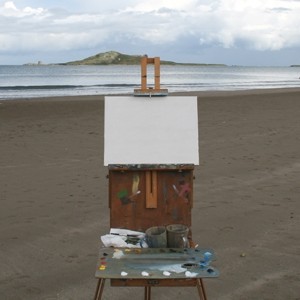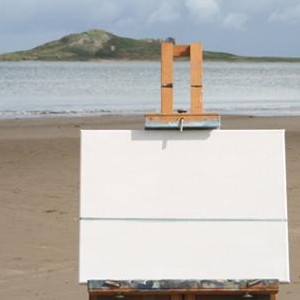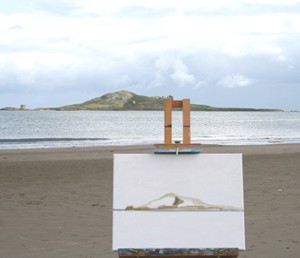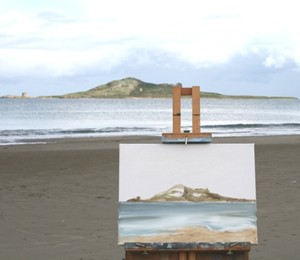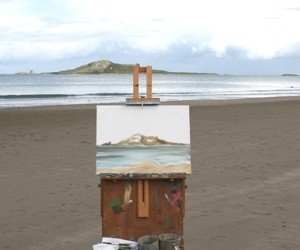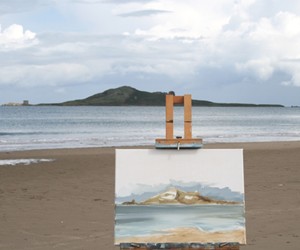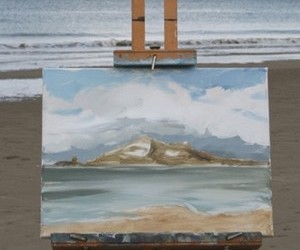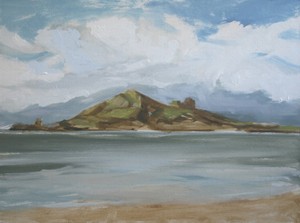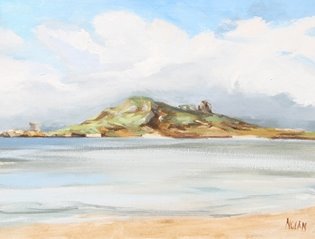Plein-Air Painting in Ireland
• Origins &
History
• Plein Air Artists of Ireland
• Irish Plein-Air Painting in the 21st Century
• ART IN THE OPEN: Ireland's Plein Air Painting
Festival
• How to Paint Outdoors: A Visual Demonstration
Origins &
History
The tradition of plein-air
painting (as opposed to studio work) reached its apogee in the 19th
century in France, when artist colonies sprang up all over the country
from 1840 onwards in villages like Barbizon,
Grez-sur-Loing, Pont-Aven, and Concarneau. Inspired by pioneers like John
Constable (1776-1837) and Richard
Parkes Bonington (1802-28) from the school of English
landscape painting, as well as Theodore
Rousseau (1812-67) and Jean-Francois
Millet (1814-75), and initially linked with the Naturalist and Realist
movements, which were themselves a reaction to the social changes caused
by the Industrial Revolution, the principles of plein-air art later
formed the core of Impressionism
- specifically Impressionist
landscape painting - as practised by
Monet (1840-1926) during the last 30 years of the century. Other leading
plein-air Impressionists included Camille
Pissarro (1830-1903), Pierre Renoir
(1841-1919), and Alfred Sisley
(1839-1899), all of whom made significant advances in the depiction of
light. It was Monet, however, who adhered most closely to the practice
of plein-air methods, continuing to refine his painterly techniques
(even when plagued with failing eyesight) in his monumental series of
water lily paintings completed in his garden at Giverny, until in death
in 1926.
Plein Air Artists
of Ireland
Nineteenth century Irish
landscape artists were also active exponents of outdoor painting.
Many of them travelled to the Continent to study fine art in Antwerp or
Paris, and afterwards joined one of the rural artistic communities listed
above. This group included such Irish artists as: Nathaniel
Hone the Younger (1831-1917), perhaps the finest Irish landscape painter
of his era, Augustus Nicholas
Burke (1838-91), Aloysius
O'Kelly (1853-c.1941), the society painter Henry
Jones Thaddeus (1859-1929) and the romantic artist Frank
O'Meara (1853-88). Later Irish emigrants included the Impressionists
Roderic O'Conor (1861-1940)
and Walter Frederick Osborne
(1859-1903), Joseph
Malachy Kavanagh (1856-1918), John
Lavery (1856-1941), Nathaniel
Hill (1861-1934) and Dermod
O'Brien (1865-1945). Another visitor to Brittany was the Dublin-born
artist Stanhope Forbes
(1857-1947), later an important member of the innovative Newlyn
school of landscape painting, together with the Limerick-born artist
Norman Garstin (1847-1926).
The 'Breton tradition' was continued in the 20th century by figures like
William John Leech (1881-1968).
A number of famous landscape
paintings were produced by these visitors to France, including Old
Mill At Grez (1882, Hugh Lane Municipal Gallery of Modern Art, Dublin)
by Frank O'Meara; On the Loing (1884, Private Collection) by John
Lavery; Apple Gathering, Quimperle Brittany (1884, National Gallery
of Ireland) by Walter Osborne; and Field of Corn, Pont Aven (1892,
Ulster Museum) by Roderic O'Conor.
At home, the plein-air tradition
was vigorously maintained by people like Paul
Henry (1876-1958) and James
Humbert Craig (1878-1944) in their powerful West of Ireland views.
Noted landscape works from Northern Ireland artists included the French-style
rural views of Frank McKelvey
(1895-1975), the quiet country scenes of County Antrim and County Down
of the Belfast-Swiss painter Hans
Iten (1874-1930), and the picturesque views of Tom
Carr (1909-1999) and Maurice
Canning Wilks (1910–1984). Lastly, one should not forget the
'school' of Tory Island open air painting in Donegal
which emerged during the 1950s, due largely to Derek Hill (1916-2000)
and his unusual 'protege' the primitive Tory Island painter James
Dixon (1887-1970).
Irish Plein-Air
Painting in the 21st Century
The wild landscape of Ireland continues
to attract outdoor painters from all over the world, not least because
of its diversity: from the rugged coastline of Mayo, Galway, and Donegal,
to the limestone hills and fields of The Burren in Clare, and the Glens
of Antrim in the North. The indigenous outdoor painting tradition
is continued in the works of contemporary artists such as: David
Nolan (b.1966), John
Morris (b.1958), Paul
Kelly (b.1968), Henry
McGrane (b.1969) and Norman
Teeling (b.1944), to name but five. They are among some of the best
Irish artists.
ART IN THE OPEN:
Ireland's Annual Plein Air Painting Festival
The brainchild of a small group of friends
attending life-drawing evening classes at the Wexford Arts Centre, ART
IN THE OPEN is now Ireland's principal plein-air painting event. Now
in its third year, the festival runs during the August Bank Holiday weekend
and brings together artists from all parts of Ireland, Europe and America.
There are numerous prizes to be won, but one of the major attractions
is the opportunity to meet and socialize with painters from around the
world.
Regular "Paint-Outs"
Other ART IN THE OPEN events include
regular "Paint Outs" in the South East and elsewhere. These
are open to any artists who enjoy working outdoors. For dates and other
details, see website, below.
ART IN THE OPEN Website
For information about the annual festival
and the regular paint-outs, or to find other artists who enjoy plein-air
painting in your area, please visit www.artintheopen.org
ART IN THE OPEN is organized by
members of the South East Plein Air Painters of Ireland Association (SEPIA),
and supported by Wexford Borough Council and Wexford County Council. It
is also a member of AOIFE (Association of Irish Festivals and Events).
PLEIN EIRE Networking Website New!
For a popular forum for artists to post
and discuss their plein air paintings, and arrange where and when to meet
up, see the website: pleineire.ning.com
|
